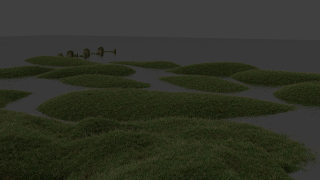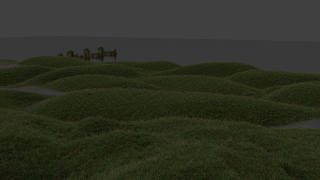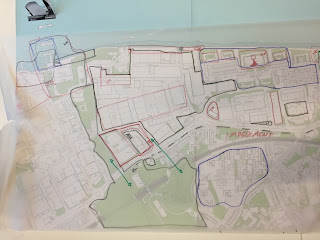Tuesday, 10 November 2015
Revised Landform
The completed landform design is now much more geometric and futuristic. This concept will also fit into my building design as it shall act as a hollow shell containing the buildings underneath.
Monday, 2 November 2015
Precedents 01 - Landscape Urbanism
Landscape Urbanism is a fairly recent theory arguing the best way to produce a masterplan or design a city is to first design the landscape rather than the buildings. By first designing the landscape of the masterplan for the specific purpose of the site it will enable me to create a better overall scheme. I will use the article, 'Terra Fluxus' by James Corner as a reading material reference for this work. Following feedback I have realised my work (intended for the year 2100) fails in two primary ways:
- The design does not reflect or support the specific planned use of the site
- The style of the park design is outdated and does not fit into the future thinking scheme
I will now begin adjusting the design away from the curvy natural style towards a more geometric and futuristic landscape that fits with the advanced ideas of the site. In order to use this I will take inspiration from projects by Plasma Studio/Groundlab such as, 'Flowing Gardens, Xi’an International Horticultural Fair 2011'. I will however maintain my initial 'island like' elements of the design.
Sunday, 1 November 2015
Urban Design - Individual Masterplan 01
For the first 'Cross Critique' of the year I decided to once again focus primarily on the area to the West of the site (current industrial park), create a visual which clearly explains my intentions for transforming the park and also an overall masterplan which demonstrates consideration has been made for the rest of the site.

 The river will flood into the site throughout the day. This periodic flooding will be controlled by an underground system that will use this natural effect to harness energy and filter the water for use in the rest of the site.
The river will flood into the site throughout the day. This periodic flooding will be controlled by an underground system that will use this natural effect to harness energy and filter the water for use in the rest of the site.
 |
| Masterplan (Click To Expand) |
As Can be seen from the plan, I have revised the proposed landform for the West of the site, construsting a more complex series of islands. This landscape will act as a constructed hollow shell. I imagine the buildings to be constructed underneath this landform and to protrude though in certain places. Above the landform will be a web of pedestrian walkways interlinked with public realm spaces. People will have the option of using these walkways when the area is flooded or walking on the grass when the water levels descend. This local transport system will work in conjunction with the sites cable car infrastructure.

 The river will flood into the site throughout the day. This periodic flooding will be controlled by an underground system that will use this natural effect to harness energy and filter the water for use in the rest of the site.
The river will flood into the site throughout the day. This periodic flooding will be controlled by an underground system that will use this natural effect to harness energy and filter the water for use in the rest of the site.
Initially I have tried to the area as an extension of the natural park to the south. Dirt tracks, random tree placement, Japanese footbridges and a curvy marshland appearance bring a natural life to the site, working with the existing environment rather than opposing it. I am not yet sure if this plan will be suitable for the site as the plan is developed further, however as a starting point it fulfils the majority of my desires for the area.
Urban Design - Individual Strip Development
Following the submission of our group work we each decided to work on a small strip of the site to develop individually. As most of my work has involved the development of the industrial park to the west of the site I was assigned a strip in this area. As the primary driving point of this development is the transformation of this industrial park into a green park I decided that most of my focus initially needed to be dedicated to working on the new land-form of the site. once solidified (corresponding with group ideas of public transport and the future function of the site, building types etc) this will enable me to proceed more efficiently with the overall master plan.
Initially as a group we downloaded quite basic 5m spot heights/contour lines. In order to understand the site more accurately and make more judicious decisions I believed it necessary to first retrieve some more detailed mapping data of the site. Fortunately for myself, in September of this year, the Environment Agency has begun releasing all 11 terabytes of it's highly accurate LIDAR data for free public use under the Open Government License to be used for any purpose. By downloading The ASC tiles for our site and using the grasshopper algorithm plug-in for Rhino, I was able to use the data to create a very accurate 3D surface of the overall site. This surface has provided much more information than the previous group contour lines and has been very useful especially with regards to issues such as flood prediction.
By selecting vertices within the surface I was able to manipulate the land-form to create the effect i desired. A new landscape continuing on from Maryon park that allows the water to penetrate the site from multiple directions. The inclusion of more flat level areas and hidden valleys also allows for possible agricultural areas and hidden building entrances. The image below is a combination of each person's individual strip, followed by a close of of my strip with a particular focus on new contour lines.
 |
| LIDAR Map Created From ASC Data |
 |
| Flood Prediction Using Horiztonal Plane |
 |
| Group Masterplan |
 |
| Revised Topographic Map |
Monday, 19 October 2015
Urban Design - Continued Group Development 05 (Energy Harvesting)
With the local plan finalised and the landform set in a way that allows for our desired movement of water I decided to start planning out in greater detail a new concept for harvesting energy from tidal river flow.
Urban Design - Continued Group Development 04 (Residential Strategy)
Continuing with the idea of a collaborative democracy within this experimental self-sustaining society we decided to implement a grid structure throughout the east side of the site. This structure, whether physical or metaphorical in nature would allow people to build temporary housing within the structure without traditional foundations. The grid would break apart in the paths of the cable cars allowing the cars to stop at any moment during the ride and allow people to simply step off onto an elevated walkway. In addition to this, we have decided to convert an existing chimney within the site into a 'drone parking facility'. Drones similar to what we have today will have the ability to delivery food etc to the residents and workers of this new society and then charge themselves on this chimney, waiting to be called into service.
Urban Design - Continued Group Development 03 (Transport)
Finalising the transport strategy was important in order to progress further and create a more detailed design. We agreed on utilising a cable car system throughout the site, therefore it was important to decide on the locations for the cable car towers (to be used as drop off points).
We based our decisions for locations on optimising views across the river, allowing enough stations spread evenly through the site (for ease of access) and to allow for future expansion/development. In addition to this we introduced a number of elevated pedestrian walkways and public realm spaces (around the towers) that would work in conjunction with the new landform and flooding strategy.
Urban Design - Continued Group Development 02 (Landform)
We began the development of our sketches with a focus on landform. As one of our main desires is to bring the river into the site and use this water in an effective way (for waste management, energy production and filtration), invariably landform design had to be considered. Through the use of our sketches we had a basic idea of how we wanted the river to move through the site, rather than flowing freely at all times, we hoped to create a number of 'pockets' that could fill as the water level rises and permeates through the ground (this landform in a tidal river would create environments suitable to deploy our energy harvesting concept).
Urban Design - Continued Group Development 01
Inevitably, as a group of 9 some views began to contrast with others and a number of groups with similar interest began to form. This led nicely into our next week's task of forming into groups of 3 and continuing the exercise with more detail applied.
Though each group decided to focus on a particular third of the site each (our being the current industrial park) we decided also to agree on a basic master plan for the entire site and then use this design to influence our more detailed area. This began with some basic sketch exercises and suggestions of how we could implement some of the larger groups desires in a strategic way.


Though each group decided to focus on a particular third of the site each (our being the current industrial park) we decided also to agree on a basic master plan for the entire site and then use this design to influence our more detailed area. This began with some basic sketch exercises and suggestions of how we could implement some of the larger groups desires in a strategic way.


Urban Design - Initial Masterplan Development
After presenting our collages as a group, we collectively agreed on positive,negative and neutral aspects of the site as well and also decided on specific buildings that we would like to keep or remove from the site. Following this we sat down as a group of 9 and began sketching out a collaborative master plan for the site. Though much of the time was spent better understanding the existing site and the proposals were quite conceptual there were a number of underlying factors that people agreed on, including:


- The pedestrianisation of the site.
- Accepting the possibility of the site flooding and using this to influence the spatial design.
- To bring the Maryon Park (South of the site) over the A206 and create a green park that extends over the area of the existing industrial park to the river's edge.
- To create a new elevated pedestrian transport system such as the use of cable cars.
- The removal of virtually all existing buildings from the site...Tabula Rasa.
- The idea of islands within the site (either physical or a metaphorical programmatic approach).
- The idea of focusing on new advanced technologies within the area of the existing industrial park.
- Break down the barriers and segregation that currently exist within the site.
- Create additional links across the river
- Creating a self sustaining site where one area may feed resources such as energy and food into another area containing residents. This closed loop system is to be one the main driving points of the overall urban strategy.


Sunday, 18 October 2015
Project 1 Collages - Quantity and Quality?
As my previous collages focused more on my thoughts of the site I decided to produce a third collage as a more informative piece to an outside viewer, it highlights some key demographic and topographic facts in a graphical representation whilst also allowing encouraging the viewer to question the certain qualitative aspects of the site.
Project 1 Collages - Tabula Rasa, Deviation and Continuity
For my second collage I decided to focus more on the historical elements of the site and the changes the site has gone through over time. Through this research I hoped to grasp an idea of what the future may hold for the site. It is clear that the site has historically had a strong connection with the leading industries of the time, whether this be shipbuilding or steam engineering. In recent years however (with exception to the housing developments) the West of the site has simply adopted a generic industrial park feel, with multiple warehouses and no particular focus (ranging sales of desk chairs and car parts to conservatory roofs).
'Tabula Rasa, Deviation and continuity' looks at how the site has changed over the years and proposes three options for the future of the Woolwich Riverside. Whilst continuing the current trend of separation between private/social housing and industrial park does not seem a viable option, ultimately the future of the site may be best suited to lie in between an entirely clean slate and a slight deviation. The industrial heritage of the site provides an interesting program for the west of the site and this combined with a desire to bring the parkland in may be a chance to create a literal 'industrial park'.
'Tabula Rasa, Deviation and continuity' looks at how the site has changed over the years and proposes three options for the future of the Woolwich Riverside. Whilst continuing the current trend of separation between private/social housing and industrial park does not seem a viable option, ultimately the future of the site may be best suited to lie in between an entirely clean slate and a slight deviation. The industrial heritage of the site provides an interesting program for the west of the site and this combined with a desire to bring the parkland in may be a chance to create a literal 'industrial park'.
Project 1 Collages - Impediment To Progress
Following my analysis of the site and James Corner's 'Taking Measures: Across the American Landscape (1996)' I decided to take a 3 part approach to the collages, each with a slightly different base theme with room for development. The first of these 3 collages focuses on the poetics of the site; the feelings I had when walking through the site and the main problems that stood out.
'Impediment to Progress' highlights what I believe to be the biggest problem with the site, the A206 acting as a barrier between a natural, full of life and energy, green park to the South and an industrial park to the North. In order for the site to develop in a positive way this barrier will have to be addressed and an intervention proposed. This may involved bridging over/tunnelling under the road, or could involve the pedestrianisation of part of the site and bypassing the main road.
'Impediment to Progress' highlights what I believe to be the biggest problem with the site, the A206 acting as a barrier between a natural, full of life and energy, green park to the South and an industrial park to the North. In order for the site to develop in a positive way this barrier will have to be addressed and an intervention proposed. This may involved bridging over/tunnelling under the road, or could involve the pedestrianisation of part of the site and bypassing the main road.
Thursday, 1 October 2015
Project 1 - Taking Measures
For our initial introduction into Unit 15, we have been asked to produce a minimum of three collages following our visit to the site (30/09/2015). As a starting point for these collages I will analyse James corner's 'Taking Measures: Across the American Landscape (1996)', with the aim of gaining inspiration to produce my own collages (highlighting both qualitative and quantitative aspects of a site).
The collages should communicate my own personal response to the site, including; social, cultural, political and historical information in addition to the required geographic, demographic and topographic data. I expect the collages to be represented as illustrative diagrams rather than artistic pieces. Each collage will be the same dimension with a minimum of 297mm along a single axis and all should have titles.
The site to be analysed is part of the Woolwich Riverside, North of the A206 and between the Thames Barrier and Woolwich ferry.
Subscribe to:
Comments (Atom)





























